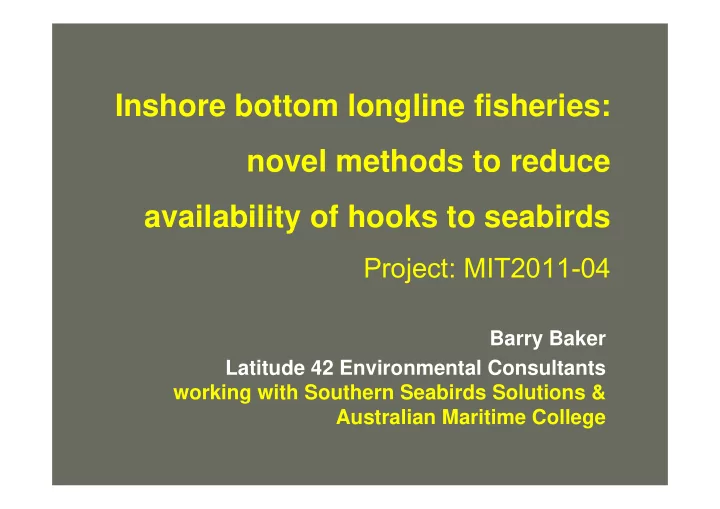

Inshore bottom longline fisheries: novel methods to reduce availability of hooks to seabirds Project: MIT2011-04 Barry Baker Latitude 42 Environmental Consultants working with Southern Seabirds Solutions & Australian Maritime College
background ─ recent seabird risk assessment work showed high potential risk that small vessel (inshore) bottom LL fisheries pose to seabirds, including the black petrel & FF shearwater (Richard et al 2011) ─ despite application of mandatory mitigation measures (BSL, line- weighting, NS, offal discharge management) there still remains the need to substantially reduce bycatch in 2 these fisheries
─ Goad et al (2011) described some initial sea trials to test and develop a novel mitigation device, the Kellian line setter) ─ trials showed the device to have utility but problems with fouling of hooks, line-weights and snoods identified ─ other work carried out on line- weighting regimes 3
Project purpose 1. to identify novel methods to potentially mitigate seabird captures in inshore bottom longline fisheries; 2. develop, test feasibility & effectiveness of methods identified, to the extent possible; 3. recommendations for future work Specific objective develop strategies to increase line-sink rates in inshore bottom longline fisheries by building on previous investigations 4
research plan ─ focus on development & testing of an underwater line setting device initially designed by Dave Kellian & further developed by Dave Goad 5
Kellian Line Setter: • developed by fisherman Dave Kellian, to mitigate catch of black petrels & FFS in NZ’s inshore snapper fishery • towed device • could be easily applied to any demersal LL operation, incl. autolining • design needs refining to resolve technical issues (gear fouling on rollers) 6
methods • assess existing prototype in short at-sea trial • develop research plan after at-sea assessment • develop drawings based on professional engineering & naval architecture advice; • fabricate a new prototype • refine design in AMC flume tank to achieve a performance standard eg. set 10,000 hooks through the line setter without a foul up. 7
Flume Tank • Circulating water tank (flume tank) at AMC, Tasmania will play a major part in refining design • Used to test the behaviour of structures in currents for oil & gas, fishing industry, defence u/w military technology • Dimensions: 17.2 m X 5.0 m X 2.5 m deep water speed 0 to 1.5 m/s Observation window 11.5 X 1.5 m 8
Research and development of: • Underwater structures & equipment • Pipelines and spar bouys • Paravanes • Fishing nets and otter boards • Vessel hull designs • Simulating currents and effects of towing underwater devices 9
Initial prototype Line setter is a towed device, consisting of : •an adjustable stainless steel tube c.1.5 m in length •a lead ball at one end •two rollers & snood & weight guides attached to other end •paravane fixed to mid section of steel tube to assist in maintaining stability • wire cable, attached to the end of the steel tube & lead ball, is used to deploy the line-setter & determine setting depth. 10
11 Initial prototype Kellian Line Setter:
key features of re-design • Reduced projected area to minimise drag. • Has a constant rearward angle on inlet to allow floats through the system easily, & to ensure hooks are swept back quickly 12
top view Rear roller is used to keep line in when weights go though the system, may require modifications to current weights, based on Dave Kellian’s advice. 13
side view Rollers have teeth & rubber insert to improve traction on mainline. Also has ability to connect the rollers so that they are always driven (DK suggestion) 14
: Roller detail. Cheeks are made of plastic, with 4mm thick rubber centre disk to grip backbone. 15
rear roller • used to keep line in when weights go though line setter • easily removed to facilitate testing • may require modifications to current weights used in fishery 16
key features of re-design • constructed in 316 Stainless Steel. • paravane & lead weight final size will be based on tests in the Flume Tank. 17
future wor k • complete fabrication of re-designed prototype (currently underway) • test prototype in flume tank & measure performance • adjust prototype as necessary to maximise performance • preliminary trial at-sea (set 10,000 hooks), subject to sufficient funds remaining • seek additional funding for more extensive trialing in fishing operations 18
Acknowledgements Scientific and Technical Support: Rowan Frost Dave Kellian Dave Goad Brian Kitty, Graham Robertson Funding: Department of Conservation – Conservation Services Programme DOC: Igor Debski 19
Recommend
More recommend